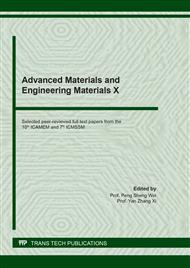p.260
p.268
p.277
p.282
p.287
p.293
p.301
p.309
p.315
Coating of Polystyrene Surface with REDV-Gelatin Conjugate for Selective Isolation of Endothelial Cells
Abstract:
Endothelial cells (EC), which line the internal surface of blood vessels, play various essential roles in controlling vascular function. The mouse is an important animal model for the study of vascular biology and cardiovascular diseases. However, the isolation of primary EC from the murine aorta is challenging because they are readily contaminated by smooth muscle cells (SMC). A previous study developed a simple method to isolate murine EC from SMC. By taking advantage of the differential sedimentation rate between the two cells, the EC was selectively enriched with collagen-coated polystyrene surfaces. Our study further improved this method by introducing a biomimetic peptide REDV (Arg-Glu-Asp-Val), which may bind specifically to EC but not to SMC or fibroblasts. Firstly, REDV-gelatin conjugate was synthesized by using the amine-to-sulfhydryl crosslinker SMCC. REDV-gelatin coating was then prepared on polystyrene surfaces, and their affinities to EC and SMC were subsequently investigated. Fluorescence microscopy and flow cytometric analysis showed that EC adhesion to the gelatin coating was significantly promoted by REDV peptide conjugation. Moreover, cell migration assay and cell viability assay also showed that the conjugation of REDV does not affect EC migration, and this coating did not show cytotoxicity against EC. This gelatin-REDV coating provides a cost-effective and straightforward tool for isolating EC from SMC, which may facilitate in vitro investigations of EC from mice.
Info:
Periodical:
Pages:
287-292
Citation:
Online since:
November 2021
Authors:
Keywords:
Price:
Сopyright:
© 2021 Trans Tech Publications Ltd. All Rights Reserved
Share:
Citation:


